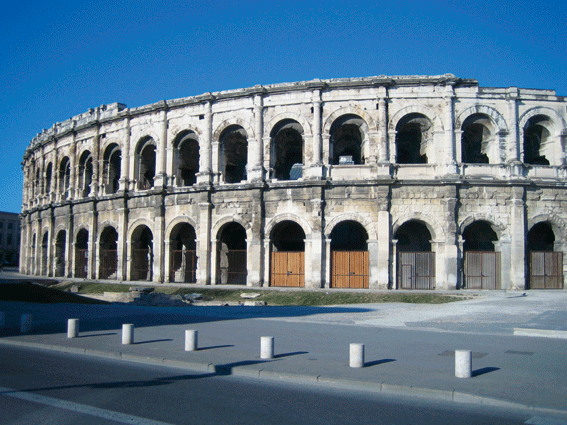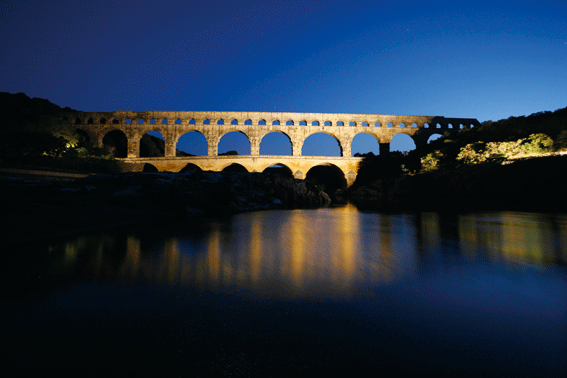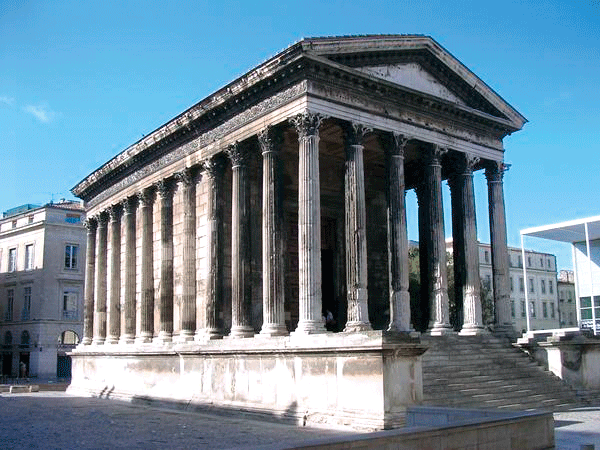
Travel
France
The Roman Influence
in France’s Past

The summer evening was autumnally cold and damp, the backless stone seats in the outdoor theater unforgiving. Many of the 8,000 spectators were irritable; most of us had shown for a rained-out performance the night before.
And frankly, I’ve seen better productions of “Carmen.” But as the performers began to move, their shadows rose 100 feet and danced across the imposing backdrop of a yellow limestone wall.
By: Elaine Sciolino
A marble statue of Caesar Augustus stood ghostly white upon his perch in the wall, his right arm raised as if he had just commanded the singers to begin their performance. When Carmen sang for the last time, a bird somewhere in the black sky sang back as her shadow fell.
|
I had been transported into the past, watching a performance in a semicircular Roman theater in the southern French city of Orange much as spectators had done 2,000 years ago. In front of me was one of the greatest works of Roman architecture and engineering to have survived the cruelty of the centuries: a theatrical wall. Despite its scarred and stained stones, the wall stands defiantly. It is still deserving of the description: “The finest wall in my kingdom,” bestowed by Louis XIV.
The performance ended, and the crowd spilled out into the streets below, just as it did in Roman times. Augustus, embraced by the shadows coursing across the theatrical wall, seemed to move as well.
Visitors to France do not usually seek out evidence of Rome’s conquest of what was then called Gaul (now essentially modern-day France and Belgium). Indeed, the French do not dwell on their colonization by ancient Roman imperialists. Instead, they celebrate the “Gallic” part: the stories of proud, strong natives who thrived in that era. (The most popular contemporary portrayals of Roman rule in France are the comic book and film adventures of Asterix and Obelix, the Gallic village heroes who use stealth and cunning against the Roman invaders.)
Over the years, I have discovered traces of Roman civilization throughout the country, from Arras in the north to Dijon in the center and Frejus in the south. My hunt for Roman Gaul has turned up treasures in the oddest places, including the middle of wheat fields, and the basements of dusty provincial museums.
Then I asked Patrick Perin, the director of the Musee des Antiquites Nationales just west of Paris, which houses the country’s finest Gallo-Roman collection, the best way to explore Roman France. He said he had two words for me: “Go south.”
Set aside for a moment images of Provence’s lavender fields, the Riviera’s beaches and Marseille’s bouillabaisse. The southeastern swath of the country seems as crammed with ancient Rome as Rome itself: temples, theaters, amphitheaters, aqueducts, roads, arches, monuments, mosaics and every sort of object from daily life.
The South of France was the first region annexed by the Romans, in about 125 B.C., decades before Julius Caesar brought the rest of Gaul under his control. The area was ancient Rome with a French twist, a synergistic blend of two cultures and lifestyles that left a permanent imprint on both of them.
The Romans relied on the native aristocracy to administer local governments. Many Gauls became citizens of Rome. Gallic silver, glass, pottery and food were exported to Italy. At a factory near Millau in the Massif Central, for example, slaves mass-produced pottery for the western half of the Roman Empire, including the entire Roman army.
To appreciate the best of Gallo-Roman France today requires only a vivid imagination and surprisingly little driving. I visited the area in several trips from Paris, but it can be covered in three or four days.
If French history books tend to underplay ancient Roman rule, local politicians and entrepreneurs in the south do not. In the summer, area restaurants offer “Roman” menus with 2,000-year-old recipes: dishes prepared with cumin, coriander, mint and honey.
In Orange, the Theatre Antique d’Orange hosts “Roman” festivals twice a year, featuring fake gladiators, processions and demonstrations of ancient Olympic games.
Residents co-exist with their antiquities with a blend of pride and nonchalance. A seller of old books in Nimes displays his collection of Roman artifacts in a glass case; the Hotel d’Arlatan in Arles has a glass floor on which guests can walk and peer down at the remains of ancient baths more than 20 feet below.
For me, the epicenter of Roman Gaul is Nimes, once one of the largest cities of the empire, called by locals “the Rome of France,” and like Rome, built on seven hills. Its amphitheater, although heavily restored, is well preserved. Unlike at Rome’s Colosseum, where passing cars and motorbikes pierce the tranquillity of the site with their noise and fumes, traffic is restricted around the Nimes amphitheater.
Le Petit Bofinger is more than the brasserie across the street. A well-positioned sidewalk table becomes the perfect perch to absorb the grandeur of the site. I felt that the visual exploration deserved a cafe gourmand – an espresso served in a gold-trimmed purplish-red cup and saucer along with miniature servings of creme brulee, chocolate cake and fromage blanc with raspberry sauce.
My guide to the area was Sophie Bouzat-Wildbolz, a Swiss-American who has been giving tours throughout this part of France for 20 years. (She works through the Nimes Tourism Board and offers both tours of the city and custom tours of the region.) She led me up stairs and through stone corridors to the highest point of the unusually shaped elliptical amphitheater. Gladiators once did battle here; now crowds come to watch modern-day re-enactments, as well as bullfights, which have been held in the amphitheater since the mid-19th century.
“The only way you can understand an amphitheater is to feel like a spectator,” Bouzat-Wildbolz said. “Imagine all the seats filled, the cries of the crowd, the gladiators in battle below.” She told me that although Nimes’ amphitheater is smaller than the Colosseum, it suffered much less degradation.
“Once you’ve seen the amphitheater of Nimes, do you have to go to Rome?” she joked. From there, we headed to the Maison Carree, an almost perfectly preserved Hellenistic-style temple in the city’s center. The temple is undergoing a major renovation and its stone is being cleaned. The limestone on the south side shines so brightly in the afternoon sun that some residents complain that it looks too new. The inside of the building has been converted to a movie theater where visitors can pay to see a 22-minute 3-D gladiator film, “Heroes of Nimes.”
With access to some of the best keys of the city, Bouzat-Wildbolz took me into private residential courtyards, including 8, rue de l’Aspic, where a Roman grave marker stands. The less grand but most intimate site came last: the so-called temple of Diana tucked away in a corner of the city’s formal 18th-century public Fountain Gardens. In a small garden filled with succulents and cactuses, we sat on a stone bench under an Aleppo pine. We were not very far from ancient Rome.
The city of Arles, 20 miles southeast of Nimes, is best known as the place where Vincent van Gogh did some of his most ambitious painting. But it is also home to an ancient theater, which is missing its top layer of stones; an amphitheater; and an underground vaulted gallery that supported the esplanade around the Forum.
The Musee Departemental de l’Arles Antique, meanwhile, housed in an airy, modern building, boasts the best collection of local sarcophagi outside of Rome.
The museum sits on the bank of the Rhone River, and in the fall of 2007 it announced an extraordinary find: Scuba-diving archaeologists, working on occasion in secret at night to avoid discovery by pirates, had pulled 20 Roman sculptures and bronzes from the river’s depths. Among them was a treasure that has shaken the archaeological world: a realistic marble bust dating from around 49 B.C., believed to be the oldest representation of Julius Caesar made during his lifetime.
Claude Sintes, the museum’s director, gave me a private viewing of the objects, which are currently undergoing restoration and will be publicly displayed for the first time this fall.
Then he led me up a flight of stairs into a locked workroom. On a shelf inside a blue metal cabinet was a plastic foam box that he carefully set on a table. Inside was the life-sized head of a man in his 50s, small-eyed, balding, with deep lines around his mouth. Sintes cradled the head in both hands and shined a light on its face.
“Here he is – Caesar,” Sintes said. “The wrinkles on his neck match those on Roman coins. There’s the Adam’s apple, just like Caesar’s. He’s balding, just as Caesar was balding. He’s human, no?”
From Arles, it is an easy 24-mile drive north to the Pont du Gard aqueduct. With its three tiers of receding arches, it is the highest Roman bridge-aqueduct in the world. It is also as worthy as the Eiffel Tower for consideration as the national symbol of France.
Once you have gone through the rather sterile visitor’s center, find a perch on the bank of the river Gardon to take in the grace of the aqueduct’s architecture and the genius of its engineering. Its blocks of limestone were pieced together without cement or mortar; it took 15 years to build. Using gravitational force, the aqueduct carried water from Uzes to Nimes 30 miles away.
Since I was part of a prearranged tour, I was allowed to climb up a winding stone staircase to the top level of the aqueduct, which stands around 49 meters high, or 160 feet (about the height of a 16-story building). From its far edge, I looked down to the river, where people fish for carp and trout in summer and walk on the stones along the bank. I continued along the path and discovered other Roman ruins in a 400-acre expanse of fields and sparse forests with laurel, oak and juniper trees.
With a bit of patience and over time, I uncovered dozens of other hidden and less-traveled sites. Outside the town of St.-Remy-de-Provence, 15 miles east of Arles, is a 60-foot mausoleum – one of the best preserved of the Roman world – and a triumphal arch.
A stone relief carved into the base of the arch is a tribute to movement: A horse rearing up on its hind legs looks as if it’s dancing; a fallen warrior is so alive that you can feel his struggle to get up. The limestone of both structures gleamed golden-white in the sun.
Across from the arch and the mausoleum, and a short way down a lane, are the Roman ruins of the town of Glanum. There, visitors can picnic under olive trees and walk along the paths of imagined streets, strolling among the ruins of fountains, shops, baths and houses.
At Vaison-la-Romaine, near Orange, the ruins of another provincial Roman town are smack in the center of the modern town. As I walked among the ancient villas floored in colored marble, I shut out the noise of passing cars. A short walk away, I found the one-arch Roman bridge over the Ouveze River.
In the end, what makes discovery of this terrain so memorable are the encounters with those who revel in their experiences with it.
Late one Sunday afternoon in July, I went exploring near Arles with Luc Long, an archaeologist and scuba diver who specializes in recovering aquatic artifacts. It was his team that had found the trove with the bust of Caesar.
He parked the car on a quiet road in front of a hand-painted sign wired to a tree with the address of a farm that sells olive oil. We walked down a dirt path along a wall of crumbling arches that had once been two parallel aqueducts. The site is called Barbegal, although it is hard to find in any guidebook.
Suddenly, we were at the top of a hill of stone, an expanse of farmland below us. He showed me the site of what had once been a vast flour mill powered not by animals, but by two rows of eight waterwheels fed by the aqueduct. Nothing resembling a mill remains – although there is a small architectural model of it at the Arles museum. Only the series of stones bear witness to what once stood. We climbed down the slippery rocks to a vault at the bottom, the place where wheat had been ground into flour.
“Imagine a great factory,” Long said. “There is poetry to be found here.” By then, a sliver of a moon had risen; the sky had turned from red-orange to slate blue. The only sound was that of a dog barking from somewhere in an olive grove at the top of the hill.
It reminded me of the bird at the amphitheater in Orange, the one that had sung to Carmen as her shadow moved.